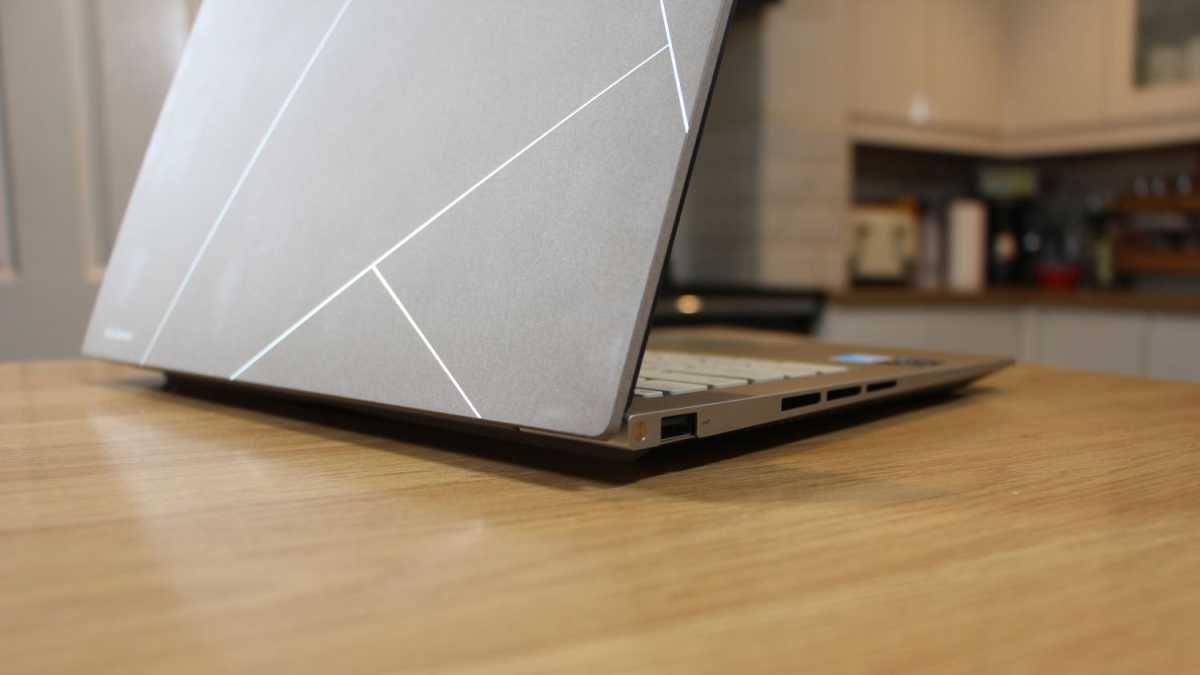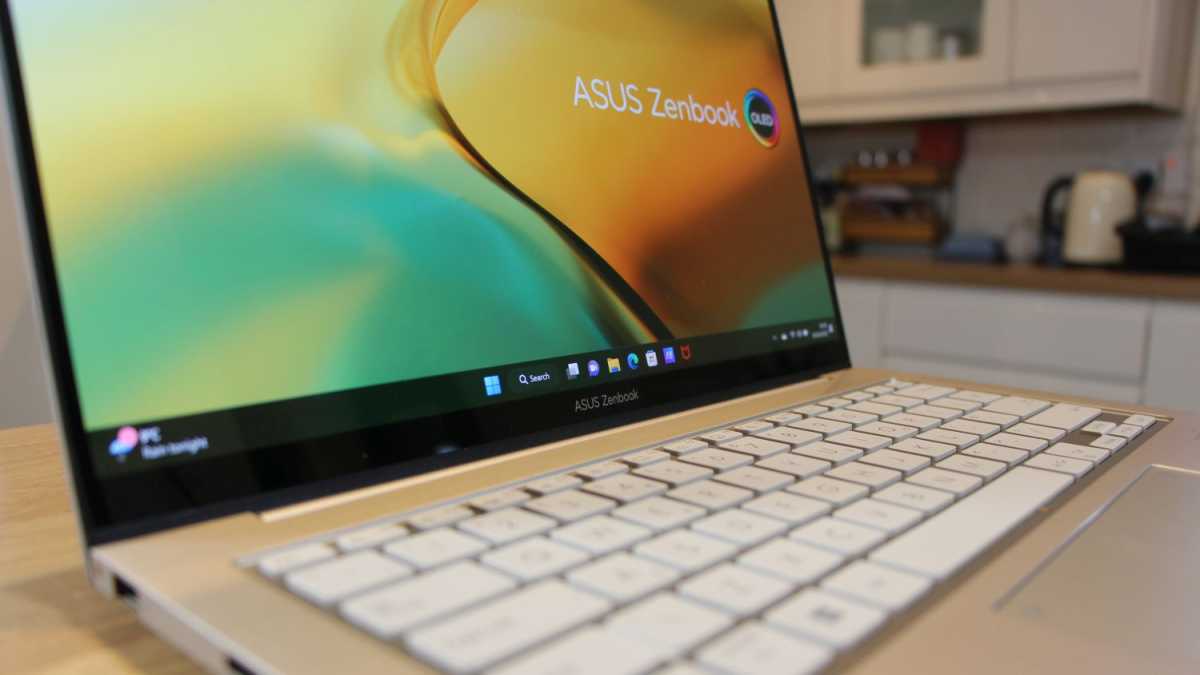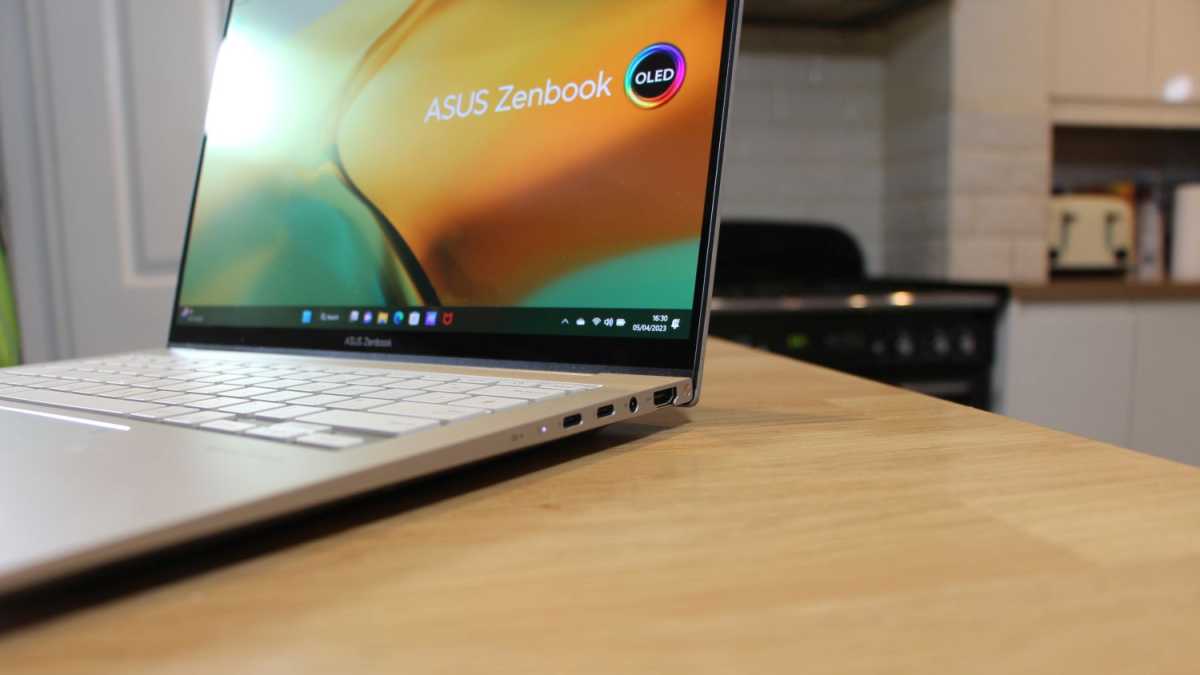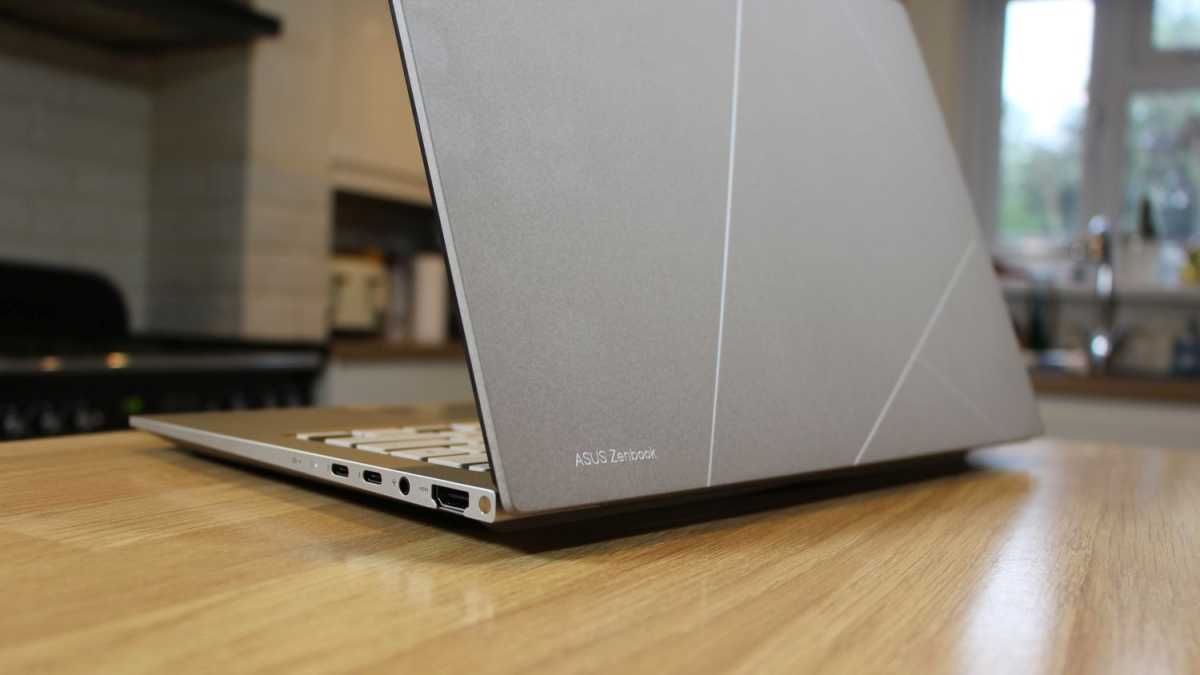Expert Rating
Benefits
- A fantastic OLED display
- Processing power loads
- Decent port selection and keyboard
- Robust, eye-catching and user-friendly design
The inconvenients
- Average battery life
- Disappointing graphics capability
Our opinion
The Asus Zenbook 14X OLED has a lot to offer, including its stunning display and powerful Intel Core i7 processor. Combine that with the solid port selection, innovative lid, and comfortable keyboard and you’ve got a laptop well suited for long workdays. It’s just a shame that the battery can’t keep up.
Spend enough time testing and writing about laptops and you won’t often see real innovation, but Asus delivered some on the latest Zenbook 14X OLED (UX3404).
Nor is it about the stunning screen technology or the surprisingly powerful Intel internals – instead, this laptop’s surprising design is on the lid.
You also don’t have to pay through your nose to get it. With a Core i7 in tow, you’ll pay $1,199 for this laptop in the US and £1,199 in the UK.
This price barely differs from the Dell XPS 13 and it undercuts the Dell XPS 13 Plus and the Apple MacBook Pro 14, so Asus might be onto a good thing here.
…the kind of coating we’ve never seen on a laptop lid before
Design and build
- An innovative, aesthetic and robust chassis
- Decent port selection
- A bit heavier and thicker than many competitors
Go for the Sandstone Beige version of the Zenbook 14X and you’ll get the kind of coating we’ve never seen on a laptop lid before.
This model uses a plasma ceramization process. The metal lid feels like ceramic – tactile and textured – and the coating helps it avoid scuffs and also keeps it from showing fingerprints.

Mike Jennings / Foundry
It looks great, especially in the sand shade of this model, and it is decorated with clean lines. The coating also does not use halogens and generates fewer emissions than other techniques. And thanks to the MIL-STD-810H certification, the build quality is impressive.
There is also reasonable connectivity. The Asus has two Thunderbolt 4 ports and a full-size USB port. It has an HDMI 2.1 output and an audio jack. Internally there’s dual-band Wi-Fi 6E and Bluetooth 5.2 and a 1080p webcam with Windows Hello, and there’s a fingerprint reader in the power button.
No Dell or Apple rivals have full size USB ports and the Dells don’t have HDMI. That said, there’s no card reader, and the MacBook Pro 14 has an SD slot.
The Zenbook 14X OLED isn’t wrong here, but it’s a bit thicker and heavier than its competitors. At 16.9mm and 1.56kg it won’t weigh down your bag, but only the MacBook Pro 14 is bigger.
Keyboard and touchpad
- Quiet and comfortable keyboard
- No numeric keypad workaround is inconvenient
- Large, fluid and precise touchpad
It might be a little heavier than its rivals, but there’s quality throughout and that extends to the keyboard.
With 1.4mm of travel, you have more movement than most laptops in this class, and that travel is paired with a smooth, quiet, and comfortable feel. It’s easily good enough for long days of typing.

Mike Jennings / Foundry
There’s no numeric keypad, but that’s normal for this size laptop. Pressing a button lays a software number pad on the trackpad, as with many other Asus models, but it’s a troublesome workaround. The trackpad is best in its more normal aspect, where it’s smooth and precise.
Screen and speakers
- High resolution OLED display
- 120Hz refresh rate
- Tiny speakers
There’s a lot to like about the display. OLED panel technology means perfect black levels and the sensational contrast you won’t get with any IPS or Mini LED panel.
The movies, TV shows, photographs, and websites all look amazing, and you’ll be hard pressed to find a rival screen that compares
The 2880 x 1800 resolution offers crisp images and plenty of screen real estate for multiple windows, and the 16:10 aspect ratio adds height. More unusually, the 120Hz refresh rate provides smooth motion in every app and makes everything look smoother than conventional 60Hz displays.
The quality is not lacking either. The 0.97 delta E is huge, and the 14X’s screen rendered 100% of the sRGB gamut, 97.3% of the DCI-P3 space, and 93% of the Adobe RGB gamut.
There’s enough color here to make everything look bold and vibrant, and the Zenbook’s display can handle almost any creative task – only the most avid designers will want more Adobe RGB capability. And that OLED hardware means contrast is brilliant, black levels are suitably written.

Mike Jennings / Foundry
The movies, TV shows, photographs, and websites all look amazing, and you’ll be hard pressed to find a rival screen that compares. The MacBook models use a Mini LED which is almost as good as the 14X on the liveliness front, but these displays only exceed the DCI-P3 range. The Dell XPS 13 uses IPS hardware.
The only rival to compete is the XPS 13 Plus, but you’ll need to pay at least $1,549 / £1,699 to get this laptop with its 4K OLED display.
There’s only one problem – a lack of HDR capability. This display’s brightest levels peak at 600 nits, but that level isn’t high enough for any significant HDR impact.
If you’re interested, there’s also a convertible Zenbook 14 Flip OLED model.
Don’t expect much from the speakers either. They’re fine for background music, but a lack of bass and a slightly tinny top end paid for any high-end audio aspirations.
Specifications and performance
- Intel Core i7 or i9
- 16 GB of DDR5 memory
- 1TB SSD
Asus packs the full-powered Intel Core i7-13700H processor inside this laptop with 16GB of dual-channel memory and a 1TB SSD with reasonable read and write speeds of 4268MB/s and 3345 MB/s.
This version of the laptop uses Intel Iris Xe graphics, although in some countries you can find the 14X with an Nvidia GeForce RTX 3050 which adds basic esports and creative capabilities.
You’ll never have trouble with loads of browser tabs, and the Asus is powerful enough for light photo editing and any Office tool.
There is no competition between the i7-13700H and the low-power chips used in Dell laptops. In the Geekbench multi-core test, Asus hit 12,024, while the i7-1260P inside the XPS 13 Plus could only manage 8,781 – and the regular XPS 13 isn’t any faster.
In PCMark 10, the Asus returned a score of 5,785, several hundred points ahead of the Dells. The i7-13700H is also faster than the Apple M2 chip inside the MacBook Pro 13.

Mike Jennings / Foundry
These scores bode well for day-to-day workloads. You’ll never have trouble with many browser tabs, and the Asus is powerful enough for light photo editing and any Office tool. It’s a great all-rounder.
The exterior stays cool even though there’s plenty of CPU power inside the 14X, and fan noise is fairly quiet and harmless even when running heavy-duty applications – this is an easy-going laptop.
It’s solid, but the M2 chip inside the MacBook Pro 14 hits around 14,000 points in Geekbench and it’s faster in single-threaded workloads, so it’s a viable alternative if you want a great speed increase.
There are a few areas where the 14X disappoints. In 3DMark Night Raid, the Asus could only score 14,151, which is low even for an Intel onboard core. Don’t expect much game help here.
The weakest part of this laptop though is the battery. The 70 Wh PSU lasted 11 hours and 40 minutes in a video test, but only seven hours in a daily work test. It’s not a ruinous result, but a full day’s work will be a struggle, and Apple’s machines are far better for longevity. At least the battery charged to 40% decent after 30 minutes of connectivity.
Price and availability
As of this writing, the Zenbook 14X OLED (UX3404) hasn’t arrived at retail, but we have RRPs and know the Core i7 model (UX3404VA) will cost $1,199 in the US and $1,199 £ in the UK.
It’s a reasonable price. The Dell XPS 13 is sometimes cheaper – an equivalent spec costs $1,099/£1,199. But while this laptop is lighter than the 14X, it’s much slower and doesn’t have an OLED display.

Mike Jennings / Foundry
The Dell XPS 13 Plus costs $1,249 / £1,499 with a Core i7 processor, but that chip is slower than the CPU inside the Asus – and that price goes up if you add the OLED display.
Unsurprisingly, both MacBook models are more expensive. The MacBook Pro 13 can’t compete in speed but still costs $1,299 / £1,349. The 14-inch version is faster, but you’ll have to pay at least $1,999 or £2,149 for the privilege.
You’ll get more power if you buy the Core i9 version of this rig, but the performance difference isn’t huge and the price comes in at around $1,499/£1,499. This model is therefore less tempting.
Check out our chart of the best laptops and best 2-in-1 laptops if you want to see more options.
Verdict
This affordable price is one of the impressive attributes of the Asus Zenbook 14X OLED. It doesn’t just undercut its rivals at checkout: it beats them out thanks to the Core i7 processor and also has a better display than most.
The beige model’s sleek looks combine with a comfortable keyboard and decent connectivity to create a laptop with the power and ability to handle most day-to-day tasks.
Battery life is the 14X’s biggest weakness, and we’d recommend a MacBook if you need all-day longevity – and the 14-inch model if you need even more speed.
In most situations, however, the Asus Zenbook 14X OLED ticks the right boxes. It is a stylish, impressive and affordable all-rounder.
Specifications
- Model tested
- Operating System: Windows 11 Home
- Display: 14.5-inch OLED 2880 x 1800 120Hz
- Processor: Intel Core i7-13700H
- Memory: 16 GB built-in
- Graphics: Intel Iris Xe
- Storage: 1TB PCIe NVMe MS SSD
- Webcam: Windows Hello 1mp
- Connectivity: 2 x Thunderbolt 4/USB 3.2 Gen 2 Type-C/DisplayPort/Power Delivery, 1 x USB 3.2 Gen 2, 1 x HDMI 2.1, 1 x audio
- Network: Wi-Fi 6E, Bluetooth 5.2
- Battery capacity: 70Wh
- Dimensions: 225 x 321 x 16.9mm
- Weight: 1.56kg
- Warranty: 1 year RTB
Table of Contents








